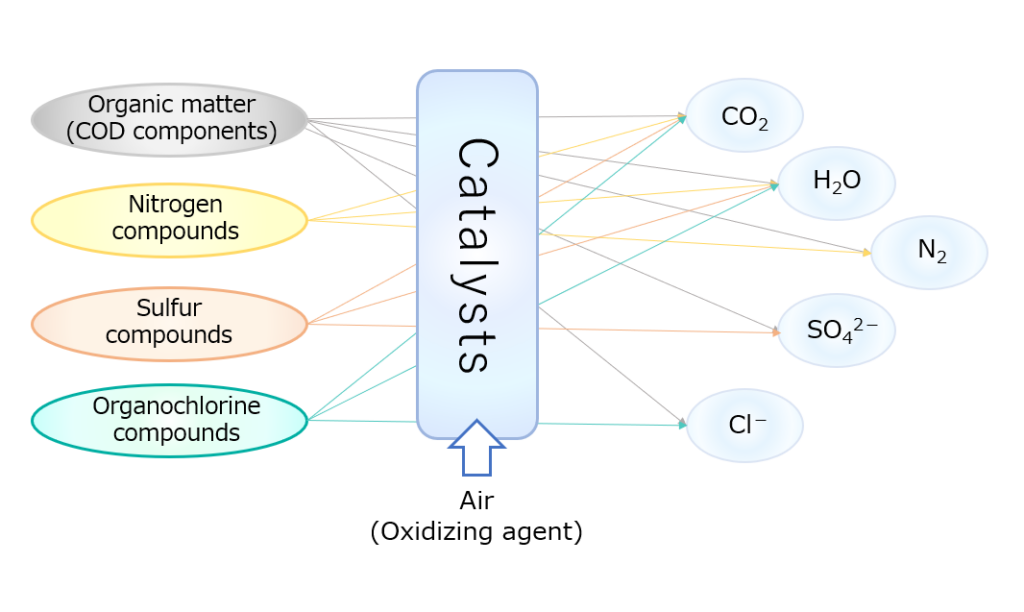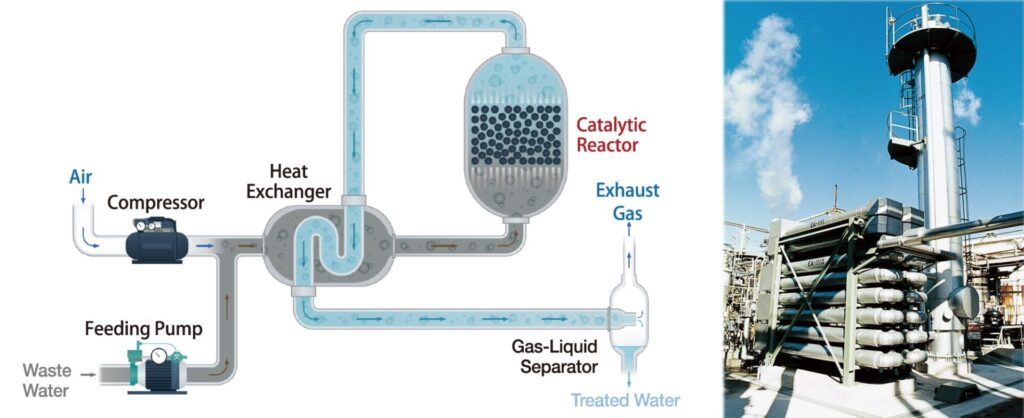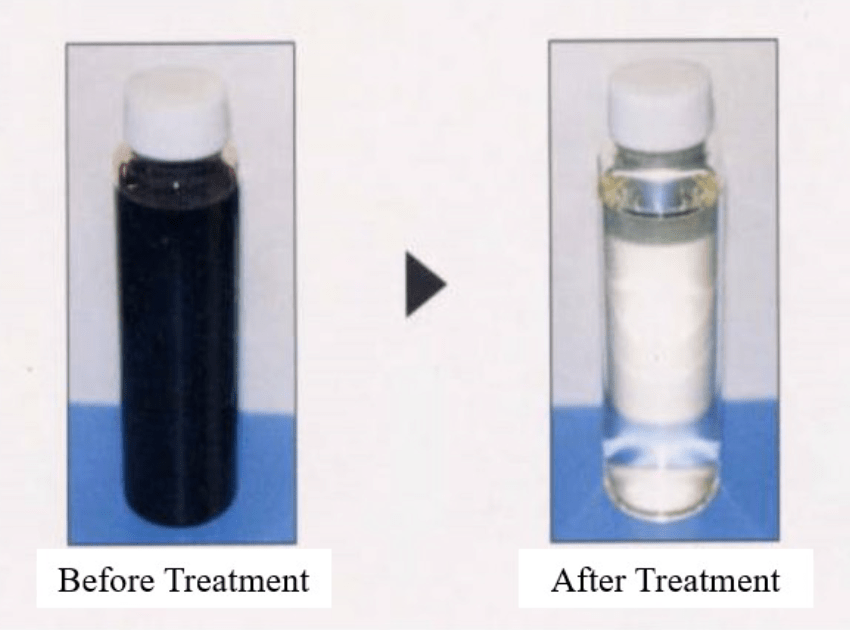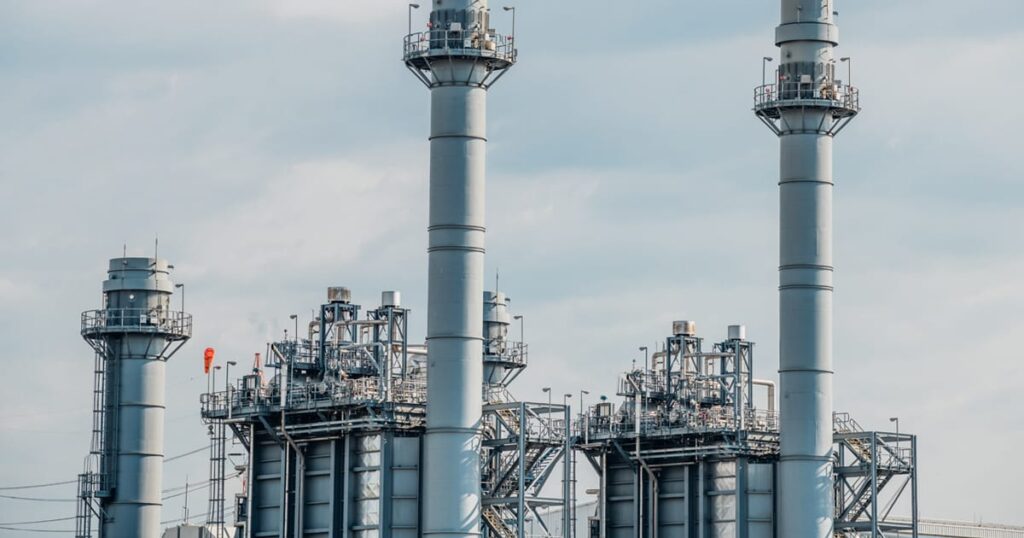Wastewater Treatment Catalysts for Catalytic Wet Air Oxidation Wastewater Treatment Catalysts for Catalytic Wet Air Oxidation (CWAO)
- Applications
- Functions
Basic Information
What is Catalytic Wet Air Oxidation (CWAO)?
Nippon Shokubai’s catalytic wet air oxidation (CWAO) is a wastewater treatment method that can be used in place of incineration treatment. We have successfully developed maintenance-free systems that are capable of highly-efficient and low-cost treatment.
Using Nippon Shokubai’s proprietary wastewater treatment catalysts for catalytic wet air oxidation (solid catalysts) to trigger a liquid-phase oxidation reaction with air as the oxidant, we can detoxify highly toxic organic matter, organic nitrogen compounds, ammonia, sulfur compounds, organic chloride, and other hazardous substances into carbon dioxide, water, nitrogen, sulfates, hydrochlorides, and other harmless substances.
We are also able to achieve even more advanced treatment by combining this process with biological treatment in the latter stages.
Features and Properties
- Simultaneous decomposition and removal of COD and compounds containing nitrogen and sulfur
- Low running costs
- Space saving, due to the compact plant design
- Stable, continuous and automatic operation
- Enables thermal self-sustained operation by recovering oxidation heat from wastewater—no auxiliary fuel needed, reducing energy costs and CO₂ emissions
- Deodorization and decolorization are also possible
- Clean exhaust gases without SOx, NOx, and dioxins
- Does not generate secondary pollutants, such as sludge and incinerated ashes
- Able to reuse the treated water as water for cisterns, fire, irrigation, etc. (in high-efficiency treatment)

System Overview

This system is composed of the processes of wastewater supply, compressed air supply, heat exchange, catalytic reaction and liquid-gas separation.
Catalysts
As the wastewater treatment catalysts for catalytic wet air oxidation, Nippon Shokubai’s proprietary solid catalyst developed are charged while in the reactor.
Comparison with Other Wastewater Treatment Methods
| Treatment Method | Catalytic Wet Air Oxidation (CWAO) | Incineration | Biological Treatment |
|---|---|---|---|
| Overview | Oxidative decomposition system using solid catalyst in liquid at up to 280℃ and up to 8MPa | Fuel-based incineration system | Treatment system using microorganisms |
| Applicable drainage | Wastewater from chemical plants, etc. | High concentration, low flow rate wastewater | Wastewater containing readily biodegradable substances (High concentrations are not allowed) |
| Advantages | ・Low CO₂ emissions ・Low running costs ・Can handle biotoxic substances ・No dedicated operator required | Capable of treating various types of persistent wastewater | ・Suitable for treating large amounts of wastewater ・Advanced treatment of easily biodegradable low-concentration wastewater is possible |
| Disadvantages | ・It is difficult to treat wastewater containing substances that poison the catalyst. ・High pressure gas application | ・High CO₂ emissions ・NOx and SOx emissions ・High running costs | Difficult to treat biologically toxic substances ・Dedicated operator required ・Excess sludge generated ・Large installation area |
Applicability of CWAO
Types of Wastewater Treatable with CWAO
- Hydrocarbon organic matter wastewater (COD components) (also compatible with sparingly degradable biological components (*))
・Wastewater containing formalin*, acetaldehyde*, glyoxal,
・phenol*, dioxane*, MMA,
・formic acid, acetic acid, acetone, tetrahydrofuran (THF), methyl ethyl ketone (MEK), methanol,
・terephthalic acid, ethylene glycol (EG), pentaerythritol, etc. - Sulfur-based wastewater containing sulfide (sodium sulfide, etc.), thiosulfuric acid, DMSO, etc.
… ethylene plant wastewater, spinning plant wastewater, etc. - Nitrogen-based wastewater containing ammonia, isocyanate, acrylonitrile, etc.
- Wastewater containing organic chlorine compounds such as dioxins, etc.
- Wastewater that has color or odor (decolorization and deodorization are also possible)

Wastewater Not Treatable by CWAO
- Wastewater containing water-insoluble solids
- Wastewater containing a large amount of oil
- Wastewater containing a large amount of scale
- Phosphorus-rich wastewater
- Wastewater with saturated salt concentration ( 15% or more)
In some cases, additional pre-processing may be sufficient to accommodate your request, so please feel free to contact us.
Application Examples of CWAO

Explore Related Case Studies and Solutions
Tailored Catalyst Selection for Your Needs
- Detailed hearing regarding the wastewater
- Sample treatment test using our in-house experimental equipment
- Based on the test results, we select and propose the most suitable catalyst from multiple options
We provide optimal proposals tailored to the type of wastewater. Please feel free to contact us.